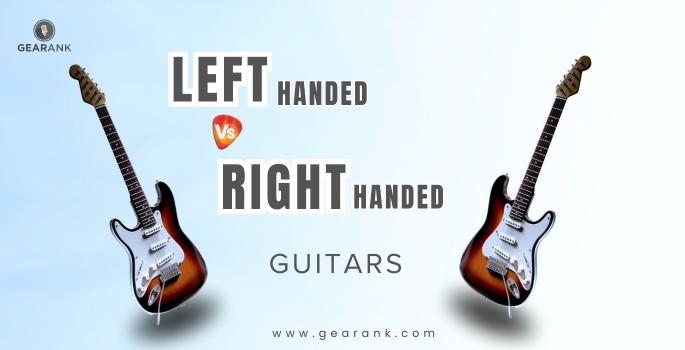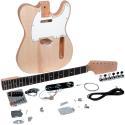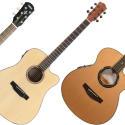Left Handed vs Right Handed Guitar

Are you a lefty and want to find out which guitar orientation is best for you? Are you curious about Jimi Hendrix playing a right-hand guitar upside down?
Here we'll take a closer look at the left-handed vs right-handed guitar options that we have in the market today.
I'll discuss the differences between the two guitars. We'll talk about the following:
-
Why Are There Two Different Guitar Orientations?
-
What Are The Differences Between Right-Handed Guitars and Left-Handed Guitars?
-
Left-Handed Vs Right-Handed Guitar: Pros and Cons
-
How To Find The Right Guitar Orientation For You?
Upon completion, you will possess a comprehensive understanding of the unique characteristics of left and right handed guitars.
Armed with this knowledge, you are well-equipped to select the guitar that suits your dominant hand and aligns with your preferences and priorities.
To start with, let's learn about the reasoning behind the two different guitar orientations.
Why Are There Two Different Guitar Orientations?
You'll notice that most guitars are made for people with the dominant right hand. This is understandable, as around 90% of people are right-handed.
However, left-handed people can also have the same interests in guitar as their right-handed counterparts.
While symmetrical guitars (like traditional acoustic guitars) would work regardless of orientation, asymmetrical electric guitars can cause issues for left-handed guitarists.
To address this, manufacturers have developed specialized left-handed guitars - this lets a left handed person play a guitar that matches their left handed orientation.
What Are The Differences Between Right-Handed Guitars and Left-Handed Guitars?
To give you a better idea, here are some features you can spot in differentiating one from the other. I'll note its defining features: (1) when held up; (2) in a guitar playing position.
EASY TO SPOT THE DIFFERENCE
-
Cutaway: At first glance, an obvious difference between left-handed guitars and right-handed guitars is their cutaway. This is more common on an electric guitar than on an acoustic guitar.
Cutaways are made to enable the fretting hand easy access to the higher frets. This is especially useful for playing leads and higher notes.
Looking at a left-handed guitar vertically, you'll notice that its cutaway is on the left side of the body. A right-handed guitar, in contrast, has its cutaway on the right side.
In a playing position, the cutaway on both guitars will always be on the lower portion of the instrument.
-
Pickguard: A pickguard is made to protect the guitar body or finish from scratches caused by the playing or picking hand.
In an upright position, left-handed guitars will have their pickguard on the left side. In contrast, right-handed guitars will have a pickguard on the right side of the guitar's body.
Both guitars will have their pickguards on the lower side of their bodies in a playing position.
-
Strap Peg: Both guitars have two strap pegs for the strap to hook onto. There are two of them on a guitar, one of the strap pegs is always on the center of the guitar's bottom end.
On the other hand, in an upright position, a left-handed guitar will have its strap peg on the left side of the guitar's upper bout. For a right-handed guitar, it's on the right side.
In a playing position, for both guitars, this strap peg should sit on the upper side of the upper bout.
-
Guitar Strings: In an upright position, you'll notice that a left-handed guitar will have its thinnest string on the left side of the fretboard. In comparison, a right-handed guitar will have its thinnest string closest to the right side.
Typically, in a playing position, the thinnest strings on both guitars should be on the lower part of the fretboard. However, other players may string their guitars the other way. Note that string orientation also impacts the orientation of the string slots on the nut.
-
Hardware: The orientation of guitar hardware changes depending on the orientation. Left handed guitars have the bridge, switch, and knobs positioned in a way that is easier to access and doesn't obstruct playing. This is one of the main issues when using guitars that aren't designed for your dominant hand orientation.
-
Saddle Alignment or Angle: A guitar's saddle affects the intonation, string tension, and string height of the instrument. This is easily adjustable on electric guitars but a bit difficult on acoustic guitars. It's usually angled in such a way that the thicker strings are longer while the thinner strings are shorter.
Holding the guitar upright, if you notice that the right part of the saddle is angled more towards the direction of the neck, that is a right-hand guitar. A left-handed guitar, on the other hand, will have its saddle pointing in the opposite direction.
Left-Handed Vs Right-Handed Guitar: Pros and Cons
Left-handed and right handed guitars are practically mirror images of each other. But aside from physical differences, there are other factors that you need to consider when choosing between the two.
Left-handed Guitar
PROS
-
Correct Hardware Orientation: A lefty will feel at home with a left handed guitar. Everything will feel natural, including the bridge hardware and controls. There won't be knobs that are awkwardly blocking your picking arm range.
-
Stand-Out: Left handed guitars easily stand out compared to conventional models. Some right handed guitarists even play inverted lefty guitars just for the sake of aesthetics.
-
Learning: As a learner, this makes lessons easier to grasp. Especially if your teacher is right-handed, your playing position will practically be a mirror image of theirs.
If you're a teacher, this makes instructions easier to explain and easier for your students to follow and understand.
CONS
-
Limited Options: Left-handed guitars can be quite rare. You'll often find situations wherein you don't see even one left-handed model in a music or guitar store.
Although you'll see lefty versions online, you'll still find it quite rare. This rarity also applies to some hardware parts, which complicates repairs and upgrades.
-
Price: Because of their rarity, these guitars often cost more than their right-handed counterparts.
And due to limited demand, manufacturing left-handed versions of guitars tends to be more expensive. This also raises its selling price.
-
Learning and Abundance of Info: Most learning materials are designed with right-handed players in mind. If you're a left-handed person, you'll need to flip the instructions, diagrams, techniques, chord shapes, etc. because they're designed for right-handed players most of the time.
-
Compatibility: Playing guitar left-handed can be quite challenging, especially if you have to play someone else's instrument which more often than not is a right handed guitar. This is the reason why some left-handed beginners learn to play a right-handed guitar to avoid the hassle. There are even some who play left handed while retaining the reverse string orientation of right handed guitars. This results in interesting reverse chord shapes and scales.
Right-Handed Guitar
PROS
-
Availability: The world's population is dominated by right-handed people by a landslide. For this reason, most guitars are designed for the use of right-handed people.
You'll find a ton of options, based on size, shape, finish, or brand. The options are endless for a right-handed guitarist.
-
Price: Because a lot of people are right-handed, guitars of this variety are the norm. It is an easy decision for manufacturers to mass-produce guitars of right-hand orientation over left-handed models.
This results in cheaper prices and better accessibility for right-handed models.
-
Easier Learning: Most learning tools for guitar, like books, videos, and diagrams, are designed with the right-handed person in mind.
This provides an enormous amount of material essential to learning guitar. You'll find countless studies on right-handed issues as well as tips that can help you learn better and get ahead of the curve more efficiently.
-
Compatibility: Playing someone else's guitar is not much of an issue for a right-handed guitarist. Even if you don't bring a guitar with you, you'll find it quite easy to find a right-handed model lying around in people's houses.
CONS
-
Over-Familiarity: Right hand guitar models, especially those of the popular guitar shapes can be too familiar. They can be downright boring aesthetically.
-
Over-abundance: Because of too many right handed models, left handed guitars are harder to find in stores. At times, lefty models are denigrated to the back room, accumulating dust.
-
Left-Handed: If you're left-handed but want a right-hand guitar because of its upside, it can be challenging to play. You'll feel awkward because you're not using your dominant hand in playing.
How To Find The Right Guitar Orientation For You?
-
Dominant Hand: The easiest way to know the right guitar for you is to align it with your dominant hand. As an adult, you've already gotten this figured out, but it's different for children.
Kids from 2-4 years old will exhibit some form of hand preference. However, it's still quite unstable, as at this stage, they'll still tend to swap their preferred hands.
From 4 years old onwards, they'll establish a dominant hand preference.
-
Writing Hand: When you're playing the guitar, you'll usually need a pick. Imagine a pen in your hands while holding the pick.
The way you hold a pen is almost similar to the way you hold a pick. So, it's safe to assume that your writing hand will most likely be your picking hand or strumming hand. On a guitar, your picking hand reflects your guitar's orientation: righty = righty guitar and lefty = lefty guitar.
-
Try It Out: If you're still not sure which orientation to get, best try out different models for yourself. This is especially true for people who are ambidextrous and cross-dominant, who can't make up their minds. Trying out instruments in general is a good practice, even for those with established dominant hand. Find out which one you're more comfortable with.
-
Aside from comfort, you can choose based on other reasons. Jimi Hendrix is a left-handed guitar player who plays a right-handed guitar upside down. Several sources provide different reasons why he does this.
The most obvious is because he couldn't find a left-handed guitar at the time. But there's a second reason, Al Hendrix (Jimi's father) believed that playing a left-handed guitar was a sign of the devil.
Final Thoughts
Now you know the issues surrounding the left-handed vs right-handed guitar discussion.
The appeal and comfort of a lefty guitar is a big consideration for left handed guitarists. However, the availability and convenience of a righty guitar is also worth noting.
As you make your choice, consider all the upsides as well as the downsides of each guitar variation. More importantly, consider the one with which you're most comfortable.
Frequently Asked Questions
Do Left-Handed People Always Play Left-Handed Guitar?
No, some left-handed guitarists prefer to use right-hand guitars. Mark Knofler, Michael Angelo Batio, and Nick Johnston are all left-handed players who play a right-hand guitar.
Can A Right-Handed Person Play A Left-Handed Guitar?
Yes, although it is quite uncommon, a right handed guitar player can play a left-handed guitar as well. Some righty guitarists decide to play left handed just for the challenge.
Why Do Left-Handed Guitars Cost More?
Left-hand guitars are less produced compared to right-hand models. This means the cost of producing these guitars is usually higher.
From the equipment to the craftsmen, making these guitars is such a niche that not everybody can be quite familiar with working on it.
Contributors:
- Jerome Arcon - Co-writer
- Jerry Borillo - Illustrator












